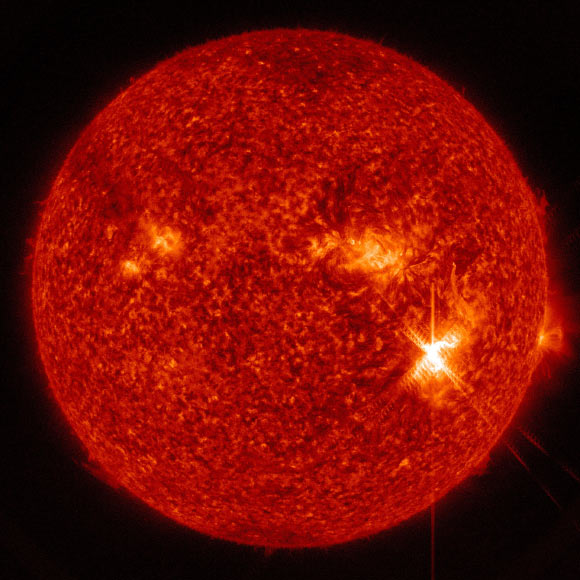On September 6, 2017, an active region on the Sun released two X-class solar flares, captured here by NASA’s Solar Dynamics Observatory (SDO).

An X9.3-class solar flare flashes in the middle of the Sun on September 6, 2017. This image was captured by NASA’s Solar Dynamics Observatory at 11:58:42 UTC and shows light in the 304 angstrom wavelength. Image credit: NASA / GSFC / SDO.
Solar flares are brief, enormous outbursts of electromagnetic radiation from the Sun lasting from minutes to hours. They produce enhanced emission in all wavelengths across the electromagnetic spectrum, including radio, optical, UV, hard and soft X-rays, and gamma-rays.
Harmful radiation from a flare cannot pass through Earth’s atmosphere to physically affect humans on the ground, however, they can disturb the atmosphere in the layer where GPS and communications signals travel.
Solar astronomers classify flares according to their brightness in the X-ray wavelengths. There are three categories: C, M, and X.
C-class flares are small with few noticeable consequences here on Earth.
M-class flares are medium-sized; they generally cause brief radio blackouts that affect Earth’s polar regions. Minor radiation storms sometimes follow an M-class flare.
Compared to C- and M-class events, X-class flares are big; they are major events that can trigger radio blackouts around the whole world and long-lasting radiation storms in the upper atmosphere.
The first September 6 event is classified as an X2.2 flare, and the second is an X9.3 flare.
“Both flares erupted from an active region labeled AR 2673, which also produced a mid-level solar flare on September 4,” SDO mission scientists said.
“The X9.3 flare was the largest flare so far in the current solar cycle, the approximately 11-year-cycle during which the Sun’s activity waxes and wanes.”
“The current solar cycle began in December 2008, and is now decreasing in intensity and heading toward solar minimum.”
“This is a phase when such eruptions on the Sun are increasingly rare, but history has shown that they can nonetheless be intense.”







